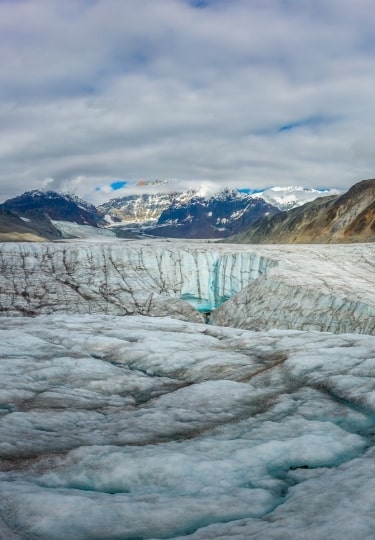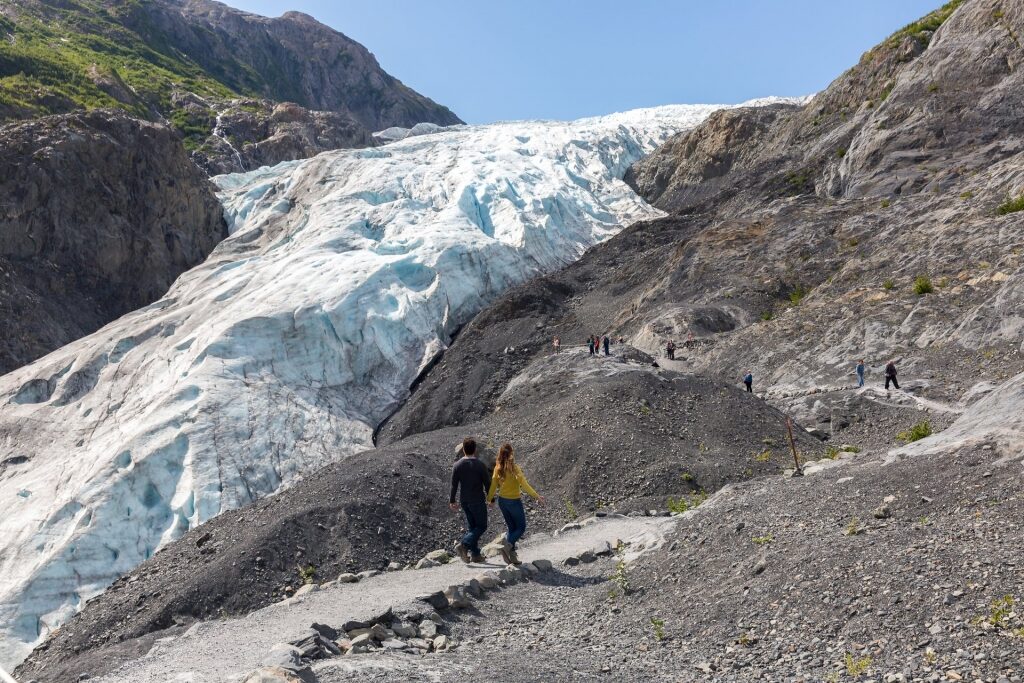Mother Nature truly outdid herself in Alaska, where glaciers tower over the surrounding seas, making their steep incline seem insurmountable.
Aside from the wonder of seeing these colossal ice walls from up close, it’s also a spectacle to watch pieces of them break down and fall thunderously into the sea; a natural phenomenon known as calving.
Here are nine of the best glaciers in Alaska to visit on your next vacation.
Hubbard Glacier
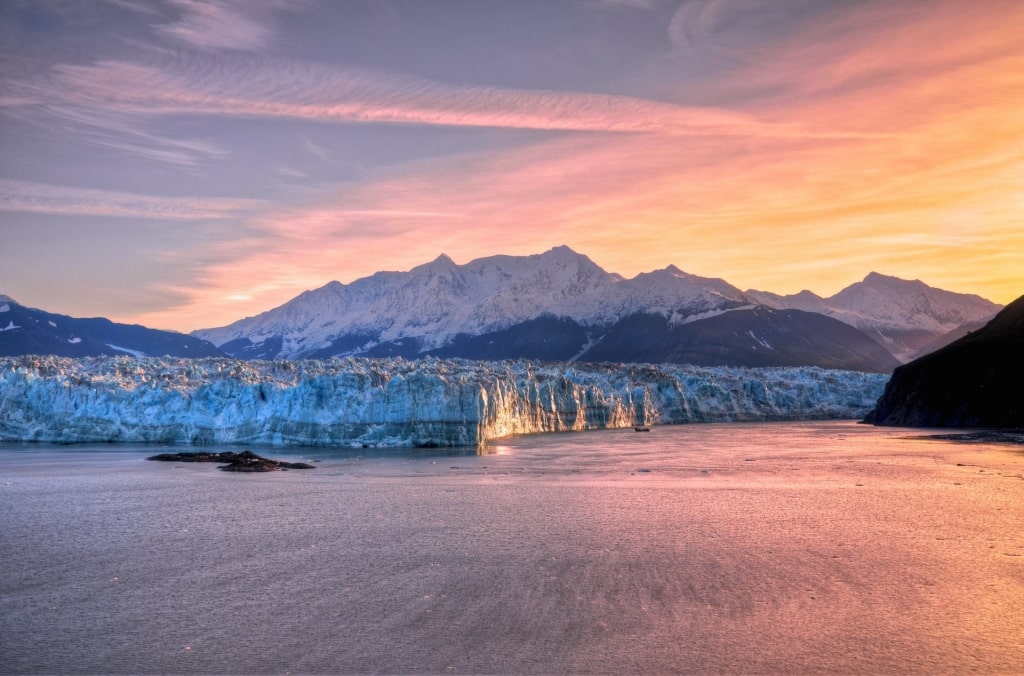
Hubbard Glacier
Hubbard Glacier is the largest tidewater glacier in North America. It was named for Gardiner Hubbard, the founder of the National Geographic Society and National Geographic Magazine.
Hubbard Glacier is over 76 miles long, seven miles wide, and as tall as a 30-story building. The first time you see its enormous facade, it will take your breath away. It’s a once-in-a-lifetime experience you’ll never forget.
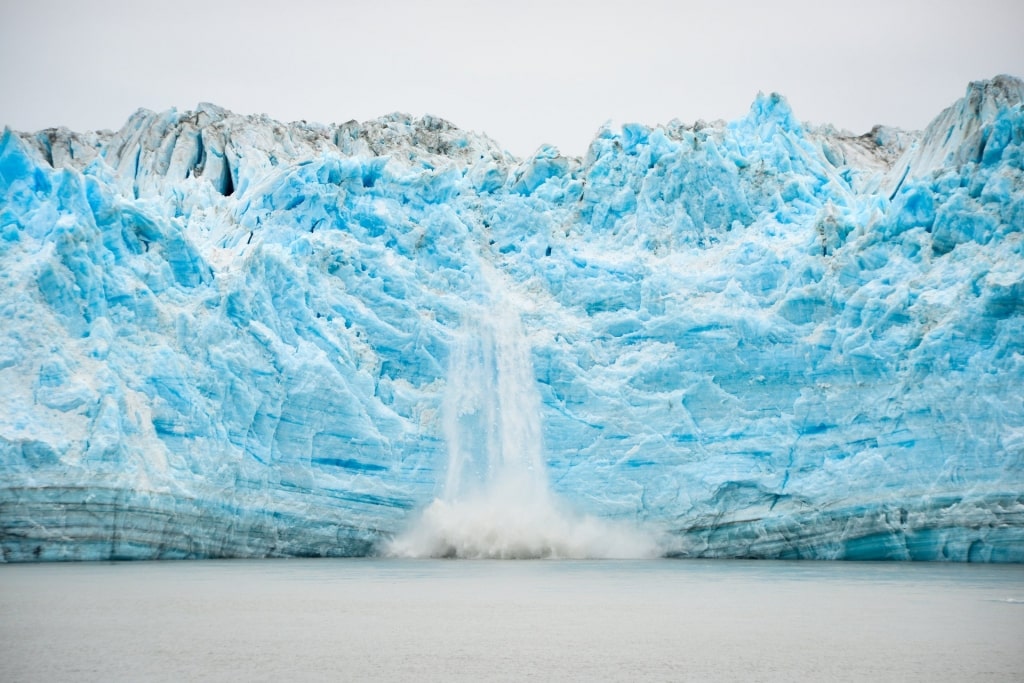
Calving of Hubbard Glacier
While many other glaciers around the world are retreating, Hubbard Glacier continues to thicken and grow (a process known as advancing), making it one of the best glaciers to see in Alaska. Hubbard calves nearly every day, making for dramatic views as ice crashes into Disenchantment Bay.
Read: Hubbard Glacier vs. Glacier Bay vs. Endicott Arm & Dawes Glacier
Dawes Glacier
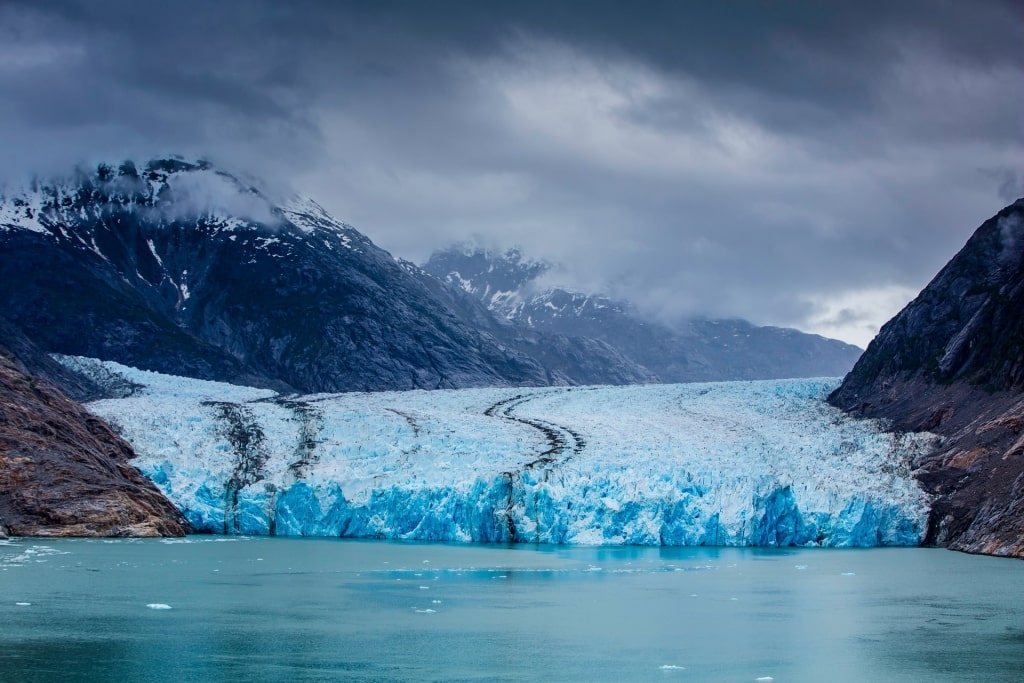
Dawes Glacier
Dawes Glacier opens into one of Alaska’s lesser-known gems, Endicott Arm Fjord. A popular way to enjoy this rugged wild frontier is by sailing through the 30-mile stretch of Endicott Arm, where you’ll see towering granite cliffs, dozens of gushing Alaskan waterfalls, and wildlife including harbor seals, bald eagles, sea ducks, and maybe even moose.
The journey ends at the spectacular Dawes Glacier, which stands at over 600 feet tall and a half-mile wide. You’ll watch as this mammoth glacier dramatically sheds icebergs into the sea below.
Mendenhall Glacier
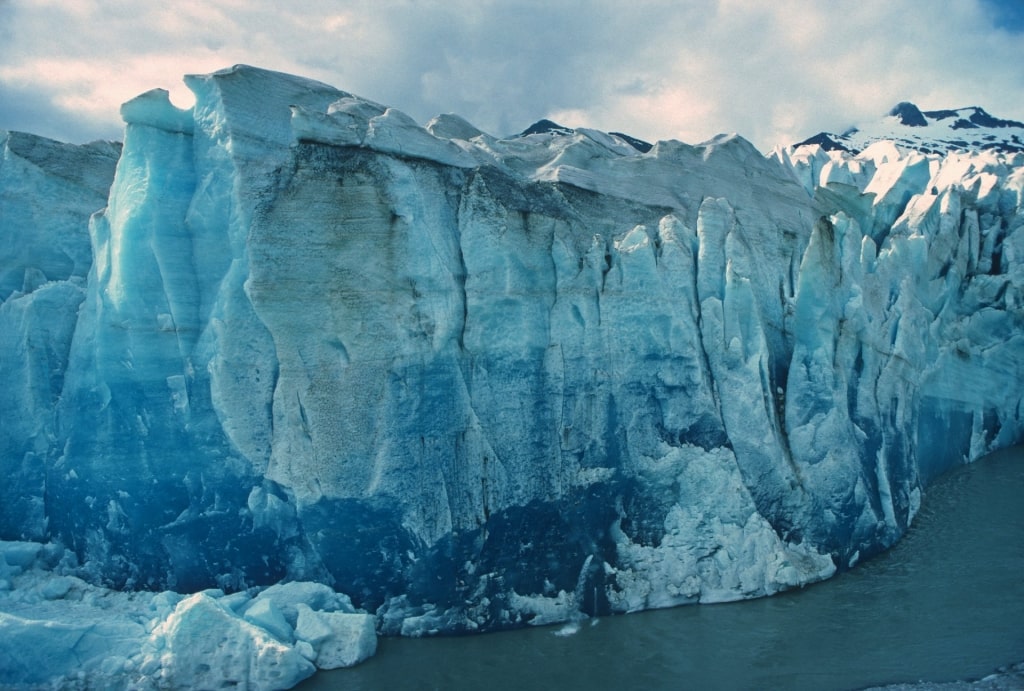
Mendenhall Glacier
Out of the over 40 glaciers that make up the Juneau Icefield, Mendenhall Glacier is possibly the most recognizable and one of the best glaciers in Alaska to visit. It’s located in Tongass National Forest, the largest protected forest in the United States, which spans almost 17 million acres.
Inside Tongass National Forest, you can hike up one of the trails to see incredible vistas of the Mendenhall Glacier, as well as spot local wildlife, including the park’s famous beavers.
Denver Glacier
Denver Glacier is nestled nearly six miles into the coastal rainforest of Alaska, closest to the town of Skagway, a small town that retains a feel of the old WIld West.
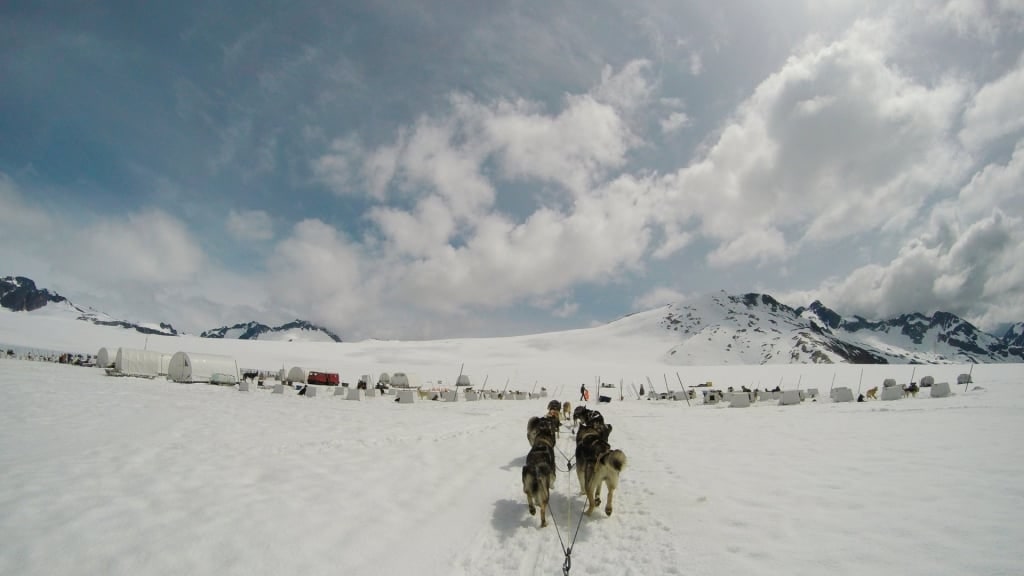
Skagway
After touring the town, take a helicopter to snow-capped Denver Glacier and go on an exciting ride with a dog sled team led by a professional guide. After all, it’s one of the best things to do in Skagway as one of the dog sledding capitals of the world.
Exit Glacier
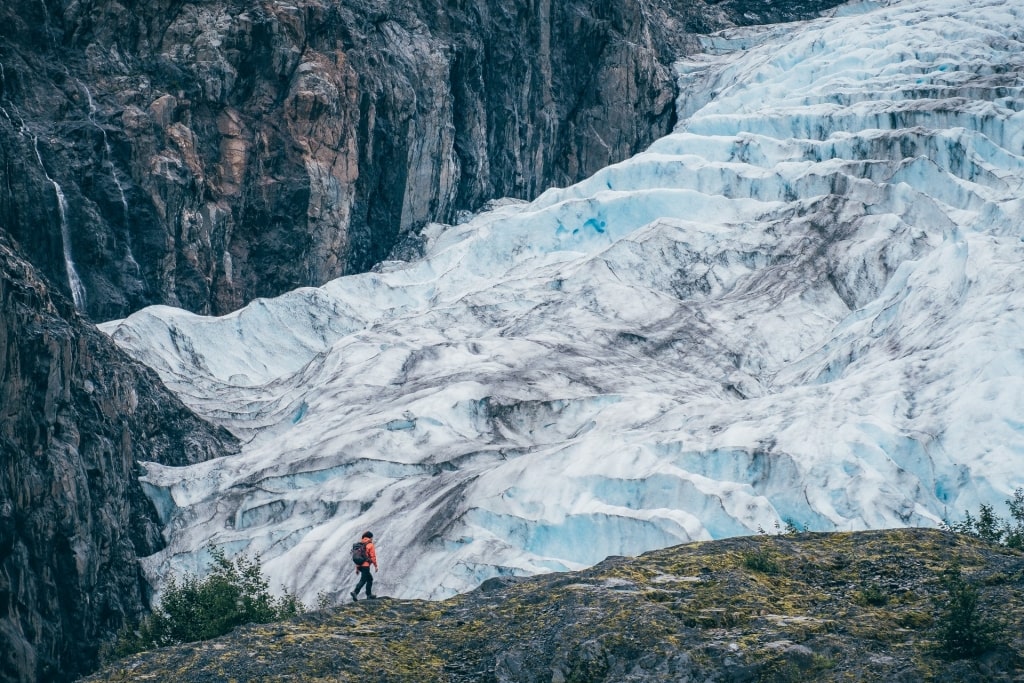
Exit Glacier
While in Seward, make sure to visit Kenai Fjords National Park, one of the youngest national parks in the U.S. More than half of the acreage of the park is ice.
Exit Glacier is the only glacier accessible via car at the park. Even if you’re not driving, you can walk from the park’s entrance to the toe of the glacier.
Witness the beauty of Exit Glacier’s sparkling blue ice and see how much it has receded in the last 120 years. During a guided tour, learn all about the plant life that has taken over the terrain after the glacier’s ice melted away. If you’re feeling adventurous, choose one of the several hiking trails available at the park that provide stunning views of the glacier.
Holgate Glacier
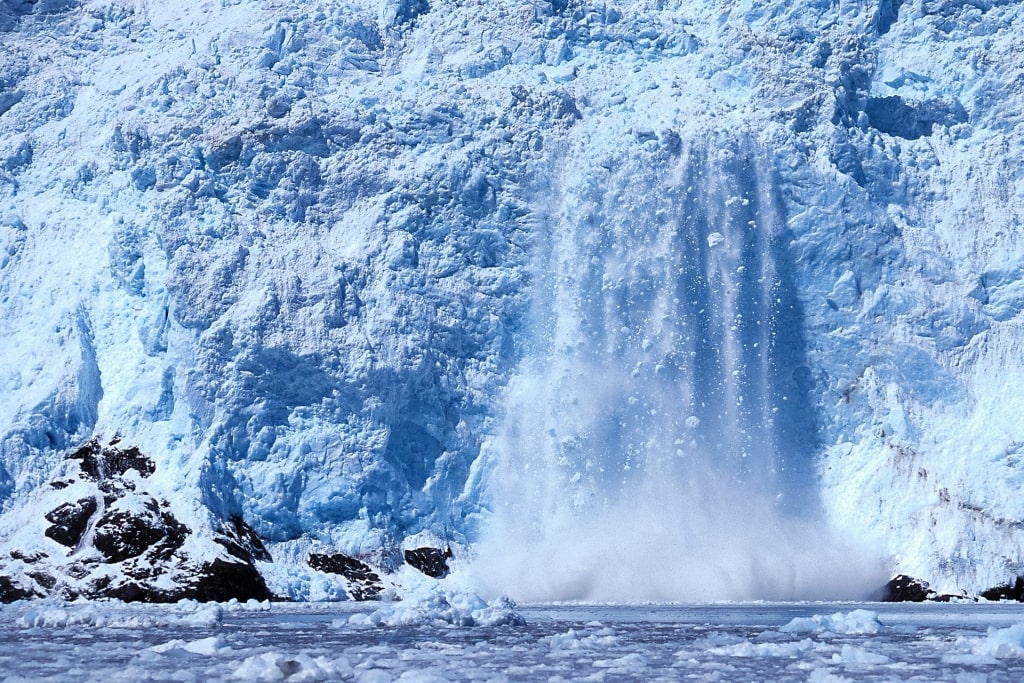
Holgate Glacier
Another popular Alaskan tidewater glacier is Holgate Glacier, which is also within Kenai Fjords National Park. Though it’s not Alaska’s biggest glacier, Holgate offers dramatic views as it calves almost a river of ice.
Aialik Glacier
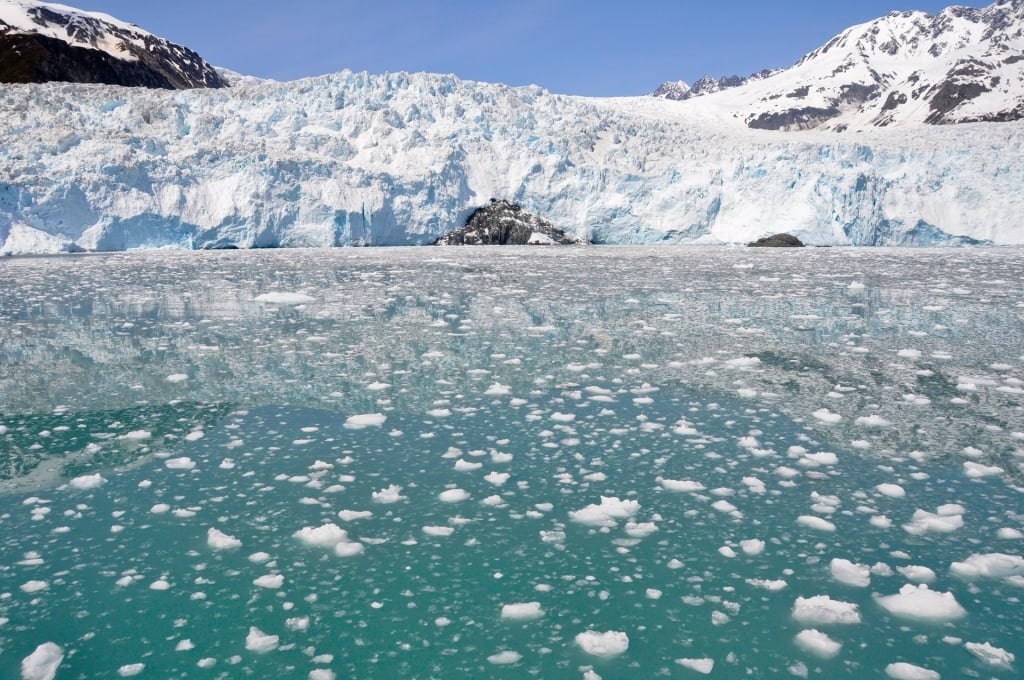
Aialik Glacier
Aialik is one of the largest tidewater glaciers in Kenai Fjords National Park. During the journey to the glacier, keep your eyes open for animals in Alaska like sea lions, porpoises, and sea otters. Though Aialik is not as active as Holgate Glacier, it is possible to see the large glacier calving, mainly in May and June.
Knik Glacier
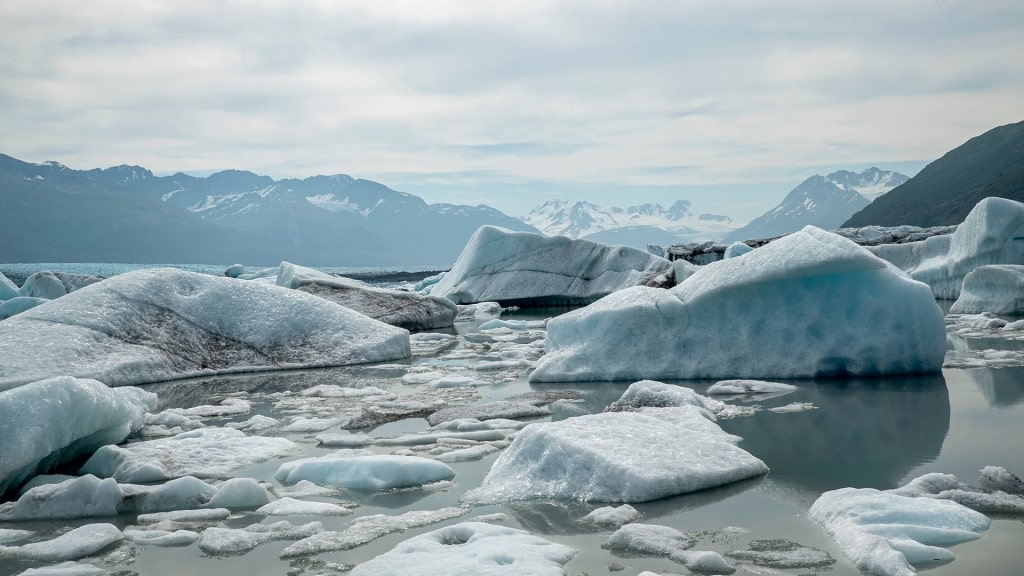
Knik Glacier
While in Anchorage, see glaciers and wildlife while soaring up in the sky on a flightseeing tour. Head to the Chugach Mountains, one of the best mountains in Alaska, where you’ll find Knik Glacier spanning over 28 miles long.
This mighty glacier used to advance every winter, and by the spring, it would dump millions of gallons of melted ice into Lake George, causing it to overflow. While this natural phenomenon no longer takes place, you can still enjoy the large Alaskan lake that lives on at the face of Knik Glacier.
Portage Glacier
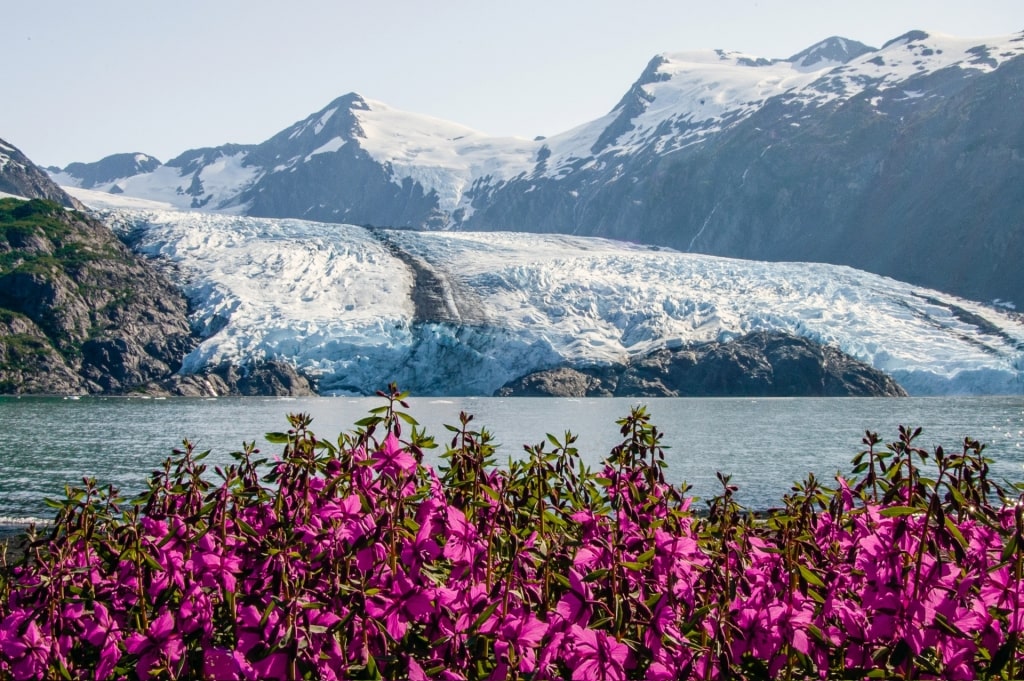
Portage Glacier
Portage Valley, located an hour-long drive from Anchorage and a 20-minute drive from Girdwood, is a stunning alpine valley dotted with ancient ice formations. The area rests on the Kenai Peninsula and is part of the sprawling Chugach National Forest.
There are a number of glaciers here, including Byron Glacier, which visitors can hike to relatively easily. Shakespeare, Burns, and other literati also have glaciers named for them here. By far the most impressive of the lot, however, is Portage Glacier. Six miles long, this mammoth river of ice descends toward a glacial lake, over which it towers roughly 100 feet tall.
The Portage Valley is accessible by car or bus and any excursion would include a short tour of the glacial lake.
Taku Glacier
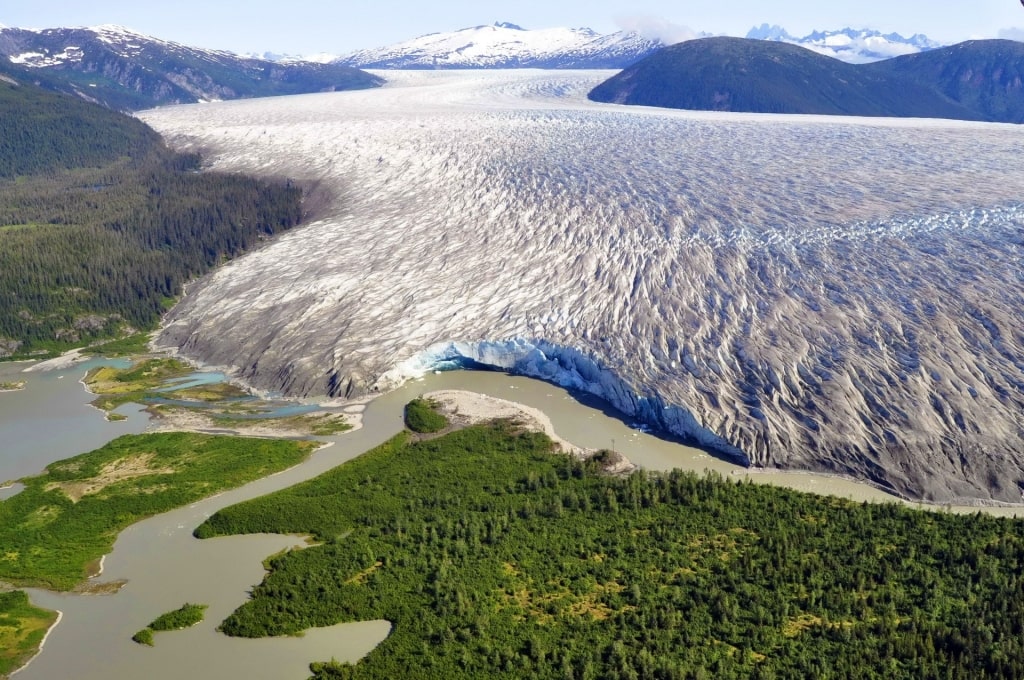
Taku Glacier
Even as the rest of the Juneau Icefield shrinks due to global warming, the Taku Glacier has continued to advance. This massive tidewater glacier measures nearly 4,845 feet at its thickest point, making it the deepest alpine temperate glacier on the planet.
The glacier’s name comes from the Tlingit language and means “fierce wind.” It’s apt, given this area has indeed been buffeted by ferocious winds and heavy snowfall for centuries.
While Mendenhall Glacier is most accessible from downtown Juneau, Taku Glacier still makes for an easy afternoon trip. Tour operators in Juneau tend to approach this river of ice two ways: by water or from the skies.
Should you opt for the latter, prepare for dazzling views of crevasses and glacial moraines from a helicopter ride. If you’d prefer the slightly slower approach by boat, you’ll be rewarded with all sorts of wildlife sightings along the way.
Alyeska Glacier
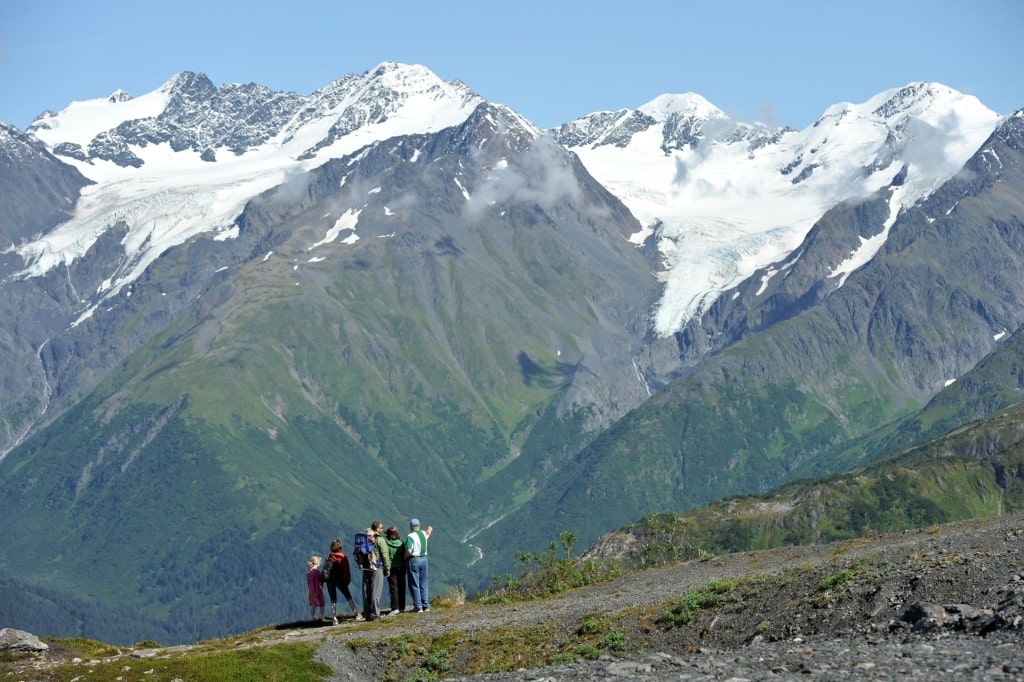
Alyeska Glacier
There’s a good reason Girdwood was once popularly known by its nickname as “Glacier City.” Although its ice formations have retreated somewhat, it’s still possible to see seven hanging glaciers, including Alyeska Glacier, here.
Travelers hoping to take in this magnificent sight have several options. Ambitious hikers and climbers head right into the mountain range, while other travelers take to the air with a helicopter tour or a prop plane.
Neither feats of mountaineering daring nor aircraft are necessary to admire Girdwood’s glaciers, however. For those hoping to take in the scenery in comfort, the Alyeska Tramway offers a swift ascent up the side of Mount Alyeska at 26 miles per hour.
Built by a Swiss company to mimic similar systems in the Alps, the tram and the viewing area at the top showcase panoramic views.
Chilkat Glacier
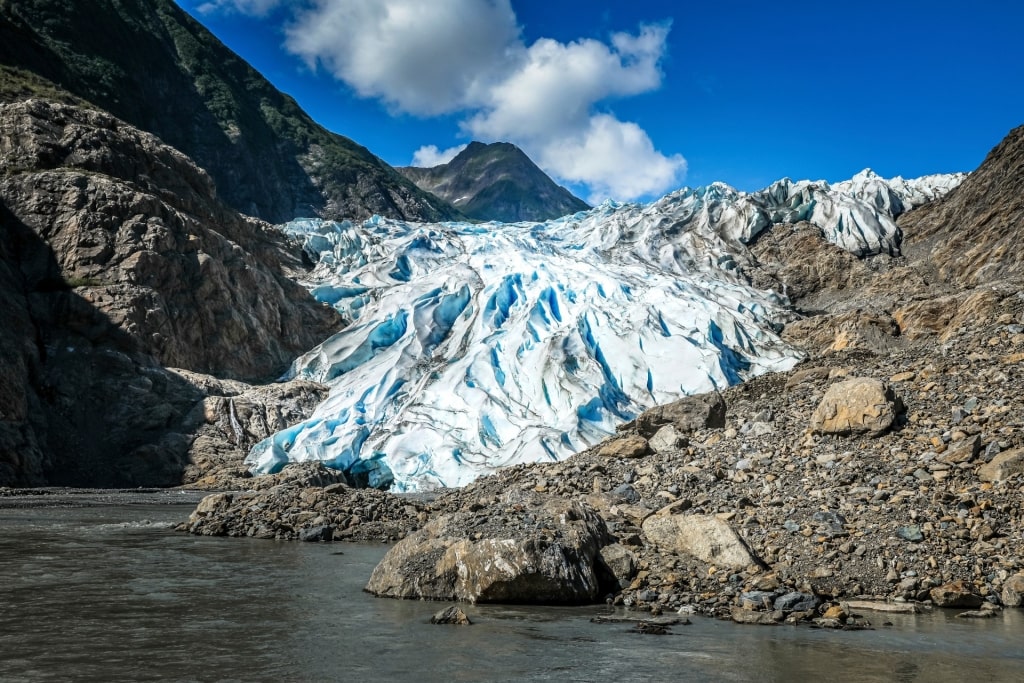
Chilkat Glacier
Situated at the mouth of the Chilkat River, this 12-mile-long glacier is perhaps best approached by helicopter. A number of tour companies offer flights from Skagway that include Davidson Glacier, plus sweeping views of the Chilkat Range.
As with many other glaciers, parts of the surface of the Chilkat Glacier are riddled with glacial pools, deep blue in color. As you fly over the ice and take in the surrounding canyons, dense forest, and jagged peaks, spare a thought for the Gold Rush prospectors who had to tackle this terrain year-round to reach the Yukon gold fields.
Davidson Glacier
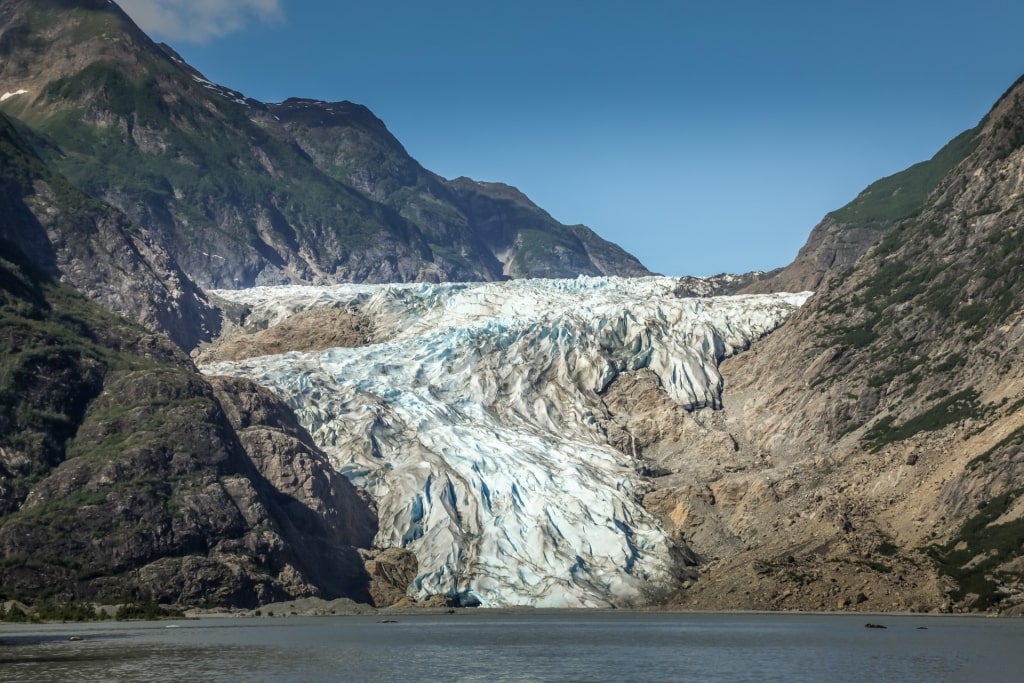
Davidson Glacier
John Muir, the famous American naturalist, rhapsodized in print about the beauty of Glacier Bay. Davidson Glacier, located out by Glacier Point across the Chilkat Inlet, was just one of the natural wonders immortalized in his writings.
It was originally known as Ssitkaje, by the Tlingit people who inhabited the region for thousands of years prior to the arrival of European colonists.
Although Davidson Glacier was once a tidewater glacier, it has since retreated far enough that it no longer touches the water’s surfaces. Most travelers observe its glittering crevasses from onboard a day cruise around the bay.
Margerie Glacier, Glacier Bay National Park
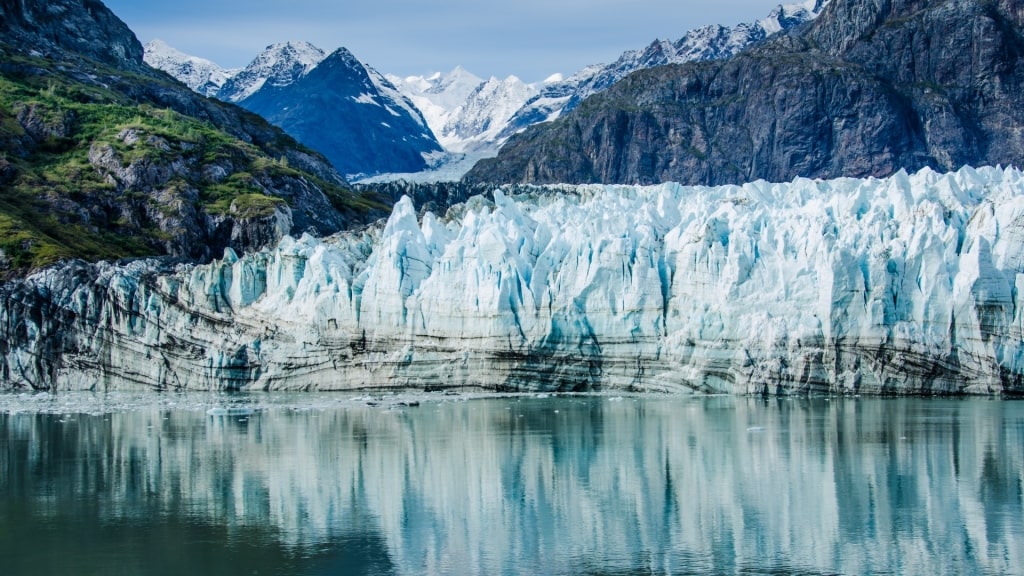
Margerie Glacier, Glacier Bay National Park
Wild and rugged, Glacier Bay National Park is easily one of the best places to visit in Alaska. The tidewater glaciers here are truly awe-inspiring, although the wildlife is arguably an even bigger draw.
Birdwatchers should be sure to pack their binoculars, as murrelets, horned puffins, and all sorts of other species call this area home. Glacier Bay is also an excellent place for whale sightings, with humpbacks and orcas both making regular appearances.
While most of Alaska’s glaciers are in retreat due to climate change, Margerie Glacier is a rare example that’s actually advancing. This 21-mile glacier is growing at a rate of roughly 30 feet per year.
The best way to see this tidewater glacier is on a guided day cruise from Juneau. Expect to see colonies of Steller sea lions and harbor seals hauled out on the rocks in the glacier’s shadow.
Matanuska Glacier
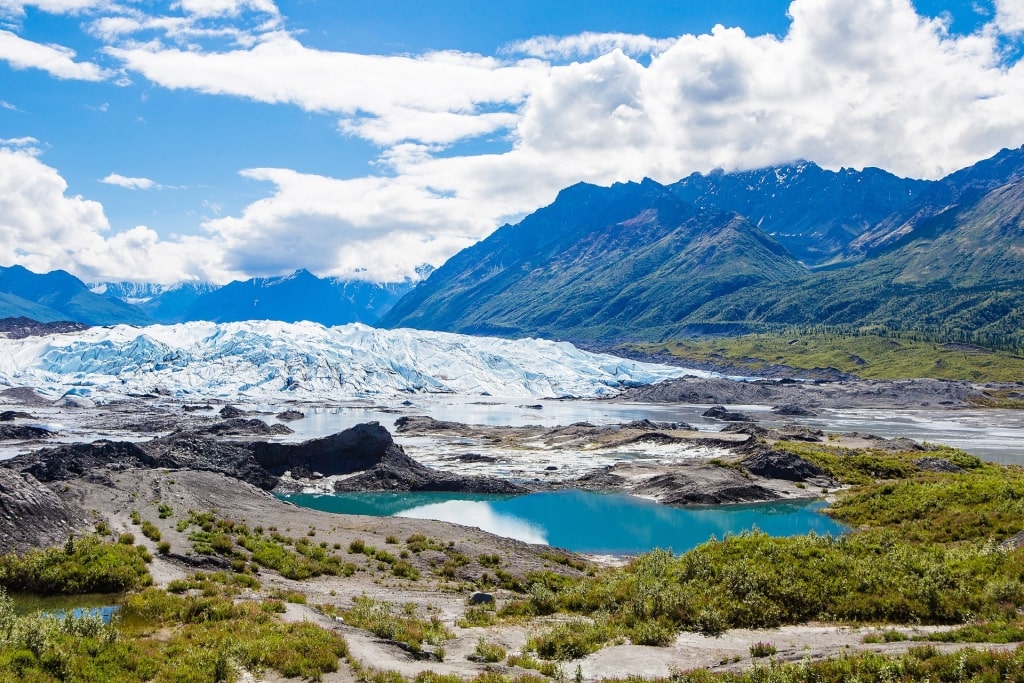
Matanuska Glacier
At 27 miles long, this sprawling, glittering mass of slow-flowing ice two hours’ drive from Anchorage is a wonder to behold. A large part of the appeal of the Matanuska Glacier is that it’s accessible by car. The famously scenic Glenn Highway will take you almost all the way there. After that, a short private road carries you to the terminal moraine.
You’ll have to trek a bit further to get to the glacier itself, but it’s worth the extra effort for one of the most picturesque places in all of North America. An interesting quirk of this valley glacier is that it creates its own weather. As a result, travelers often find it surprisingly pleasant temperature-wise, despite the massive walls of ice.
Ruth Glacier, Denali National Park
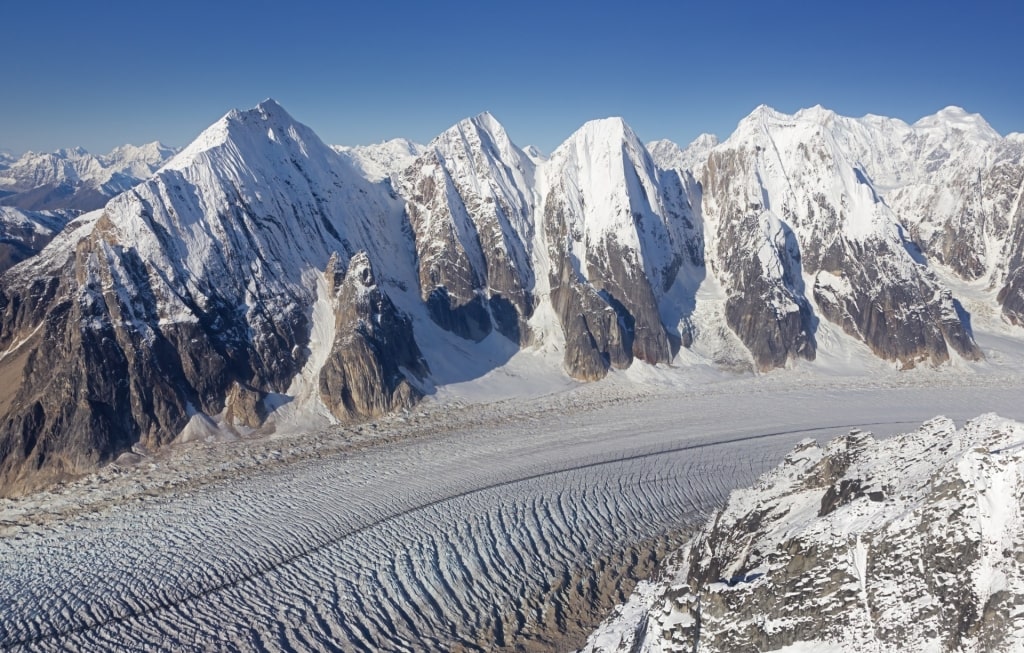
Ruth Glacier, Denali National Park
Most visitors to Denali National Park train their eyes upward in the hopes of glimpsing the tallest mountain peak in North America. The perpetually snow-capped summit, which stands 20,310 feet above sea level, is truly breathtaking—on the rare occasions that it makes an appearance from beneath its cap of cloud.
Yet as majestic as the mountain peak is, the valley of Ruth Glacier is almost as striking. The Great Gorge extends down 9,000 feet, making it deeper than the Grand Canyon. The ice is a whopping 3,800 feet thick in places.
The Ruth Glacier is somewhat tricky to access. While some travelers opt to hike out to it, those pressed for time may prefer to fly. Soaring through the Great Gorge in a small aircraft and landing on the surface of the glacier is nothing short of thrilling.
South Sawyer Glacier, Tracy Arm Fjord
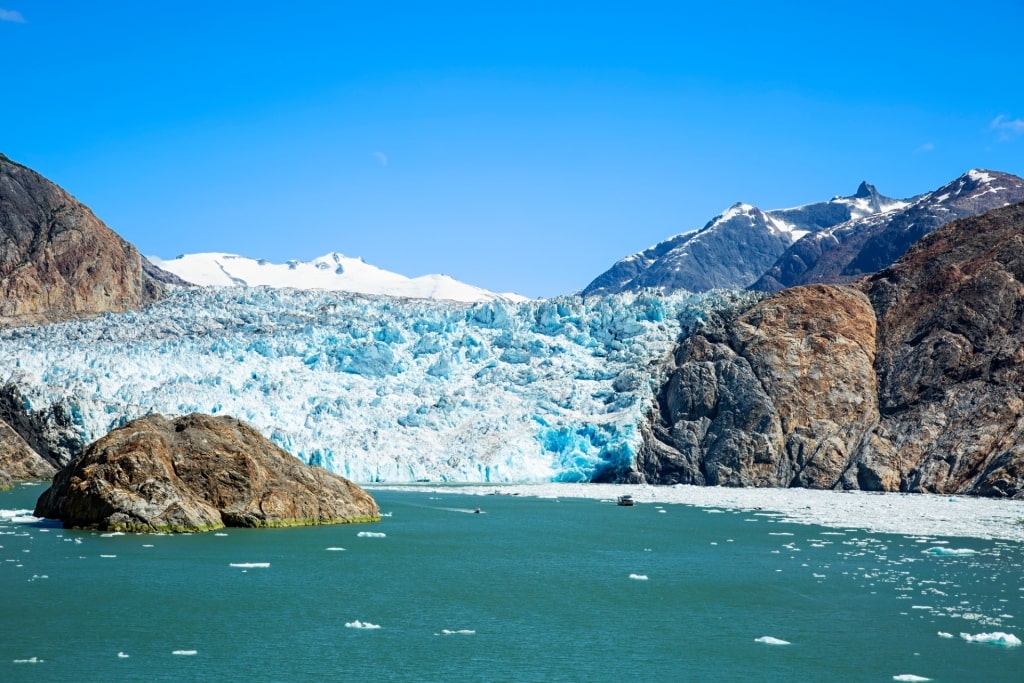
South Sawyer Glacier, Tracy Arm Fjord
Located roughly 50 miles from Juneau, the Tracy Arm Fjord boasts two tidewater glaciers. The South Sawyer Glacier is the larger of the pair. It is generally the more popular of the two to visit, although many day cruises swing by the North Sawyer Glacier as well.
Part of what makes this glacier stand out is its remarkable coloring. Because the ice of the South Sawyer Glacier is so heavily compressed, it reflects a striking, cobalt-blue color.
This is an especially good place to see a glacier calving. Nothing quite compares to the thunderous crack of truck-sized pieces of ice crashing into the water. On a clear day, boats can get within a half-mile of the glacier to witness this sight up close.
What You Should Know Before Hiking A Glacier In Alaska
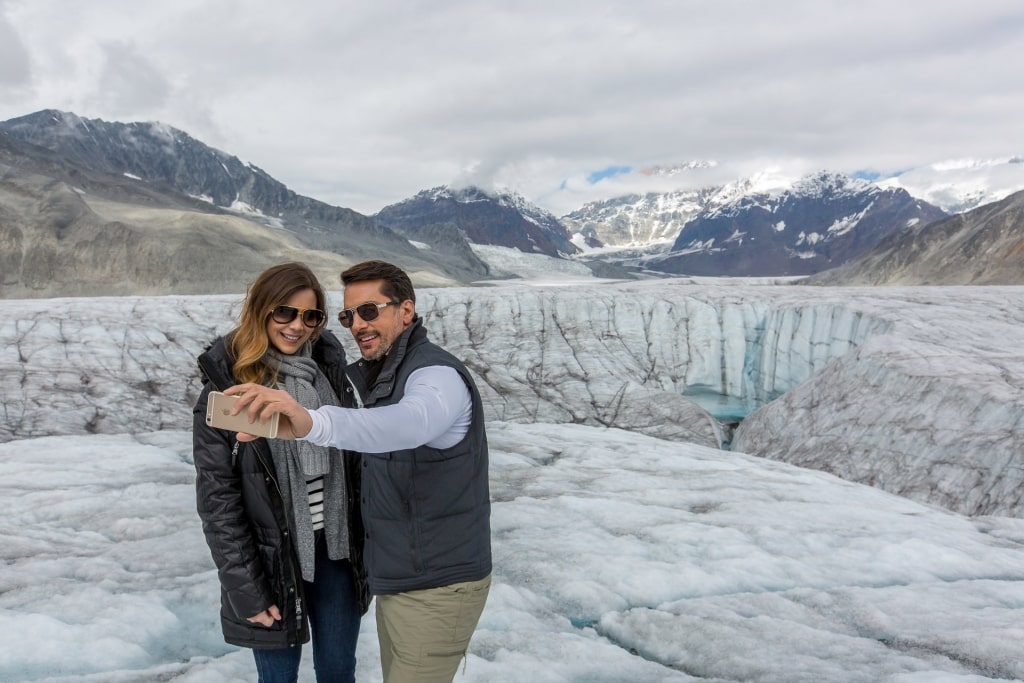
Denali National Park
Before you visit one of these Alaskan glaciers, make sure you understand the logistics and safety protocol of scaling these incredible natural wonders.
There are two main types of glaciers: dry and wet. Dry glaciers are primarily icy and not covered in snow, so hikers can predict the landscape and find potential weak spots as they walk. Wet glaciers, on the other hand, are blanketed in powdery snow and can be harder to navigate, since the snow can conceal changes in terrain.
Hiking a glacier requires special equipment and gear, such as crampons, ice axes, and helmets that make it possible to safely navigate the ice.
What type of clothing and gear should I bring for a glacier visit?
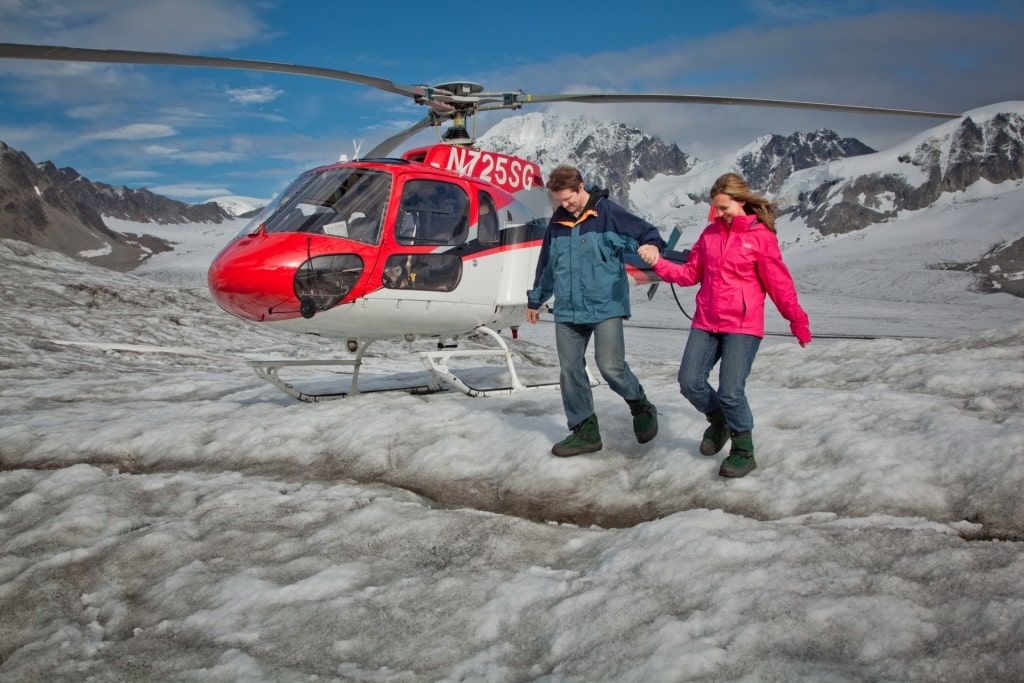
Glacier in Alaska
Even in the middle of summer in Alaska, you will want to make sure to pack plenty of warm layers when visiting a glacier. These bodies of ice are so massive that they impact everything in their immediate surroundings. Part of the thrill of approaching a tidewater glacier in particular is feeling the temperature drop as you approach.
If you’re planning on visiting a glacier by boat, pack rain gear for the voyage, regardless of the weather that day. Smaller watercraft in particular tend to splash, and the water near the glacier is predictably chilly.
If you’re hiking on a glacier, sturdy footwear with excellent traction is a must. Some travelers find Nordic walking sticks helpful on a trek. Also, even when it’s cold out, remember to bring adequate water and stay hydrated. Even if you see what appears to be a clean mountain stream, do not drink from it unless your guide says it’s OK.
Read: What to Pack for an Alaska Cruise
Are there any safety concerns or precautions to take when visiting glaciers?
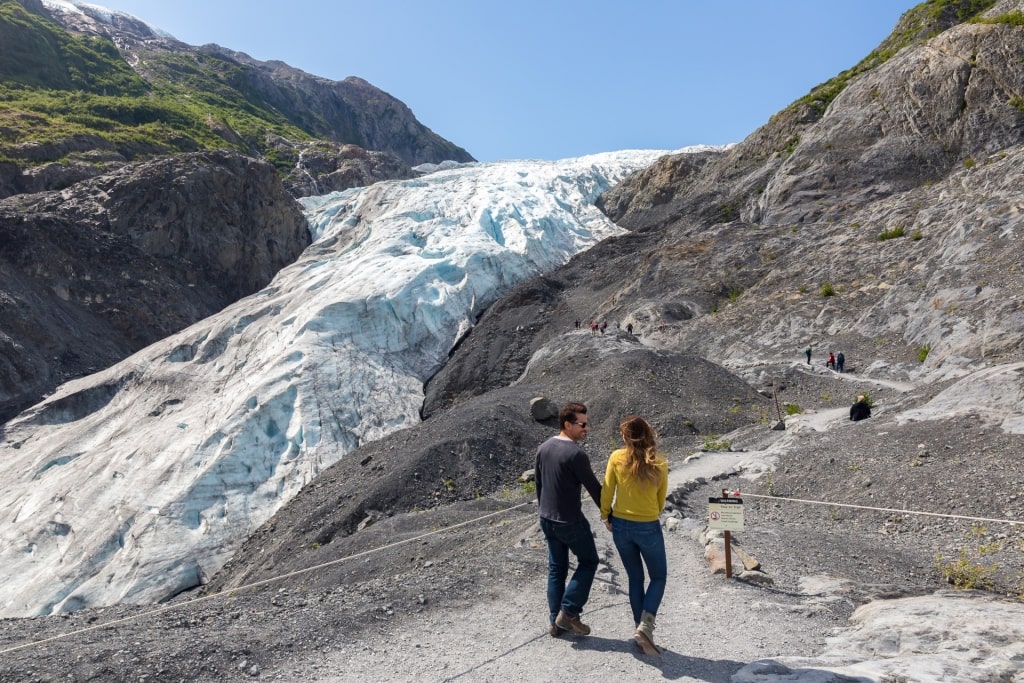
Exit Glacier
For the most part, visiting glaciers on a guided tour is very safe. That being said, it’s still important to observe a few basic precautions. Ideally, you should never visit a glacier alone.
If you’re sea kayaking near a tidewater glacier, be sure to maintain a healthy distance. Many tidewater glaciers are actively calving, meaning enormous chunks of ice could break off at any time.
If you’re walking on a glacier, you must stay within the designated trails. Glaciers in Alaska typically have clear markings as to where is safe to stand. Even if an area outside of the markers looks solid, that may very well not be the case. Crevasses can often be hard to spot from a distance and ice may be thinner than it appears.
How much time should I allocate for a glacier visit?
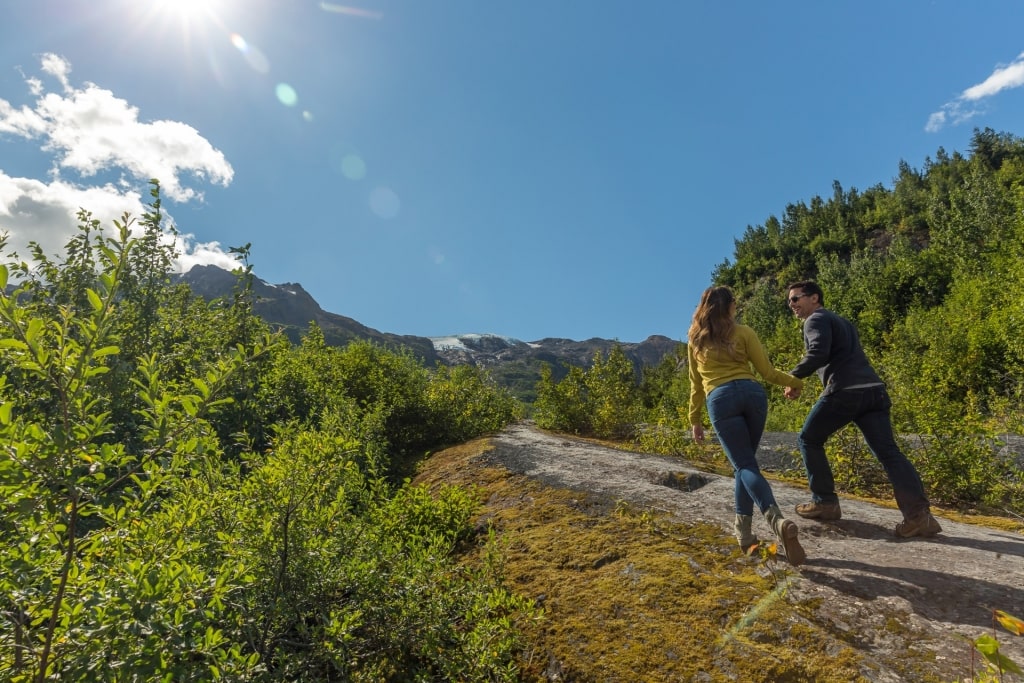
Hiking near Exit Glacier
That varies quite a bit depending on the specific glacier. Most boat cruises out to see tidewater glaciers take the better part of a day. For glaciers that are accessible by car, most travelers leave an hour or two. Travelers planning to hike or walk around the area may want to budget longer, depending on the route.
Can you see wildlife on or around the glaciers?
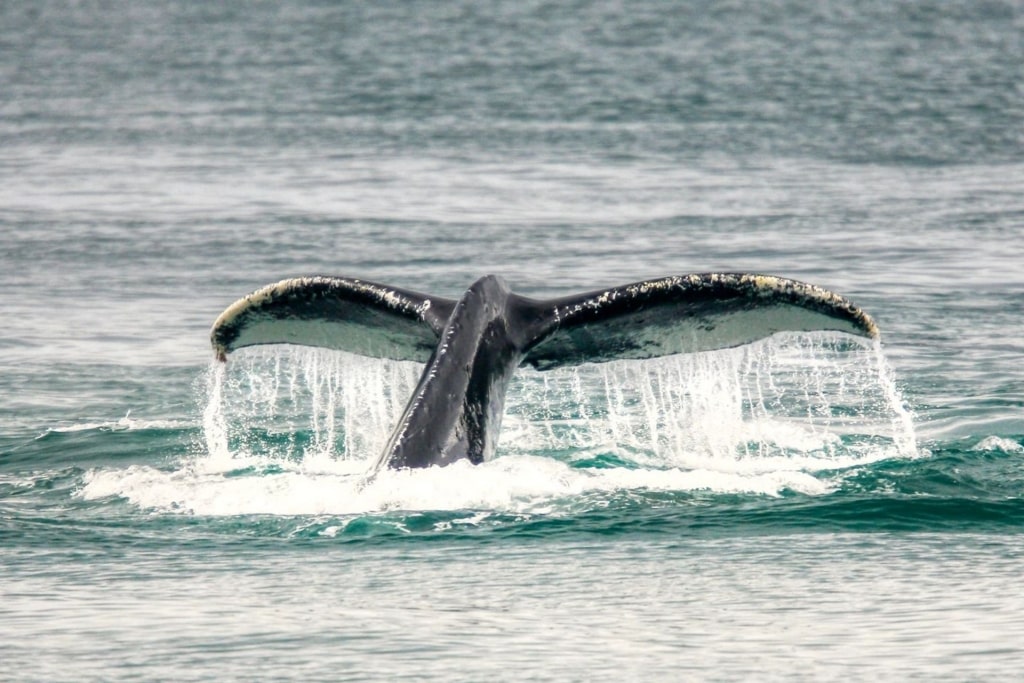
Humpback whale
Yes! Alaska’s glaciers are often terrific places to spot wildlife. Expect to see herds of snowy white mountain goats climbing on nearby slopes. Roosevelt elk, moose, and lynx may also make an appearance.
Tidewater glaciers are often surrounded by marine life. Steller sea lions, harbor seals, and sea otters make regular appearances. Humpback whales, orcas, and Dall’s porpoises are also sighted in these waters.
Both black and brown bears can be spotted near certain glaciers. These megafauna are definitely best admired from afar, however. When hiking in Alaska, remember to bring bear spray, stick to trails, and avoid trekking alone.
Are there any age or physical fitness requirements for glacier tours?
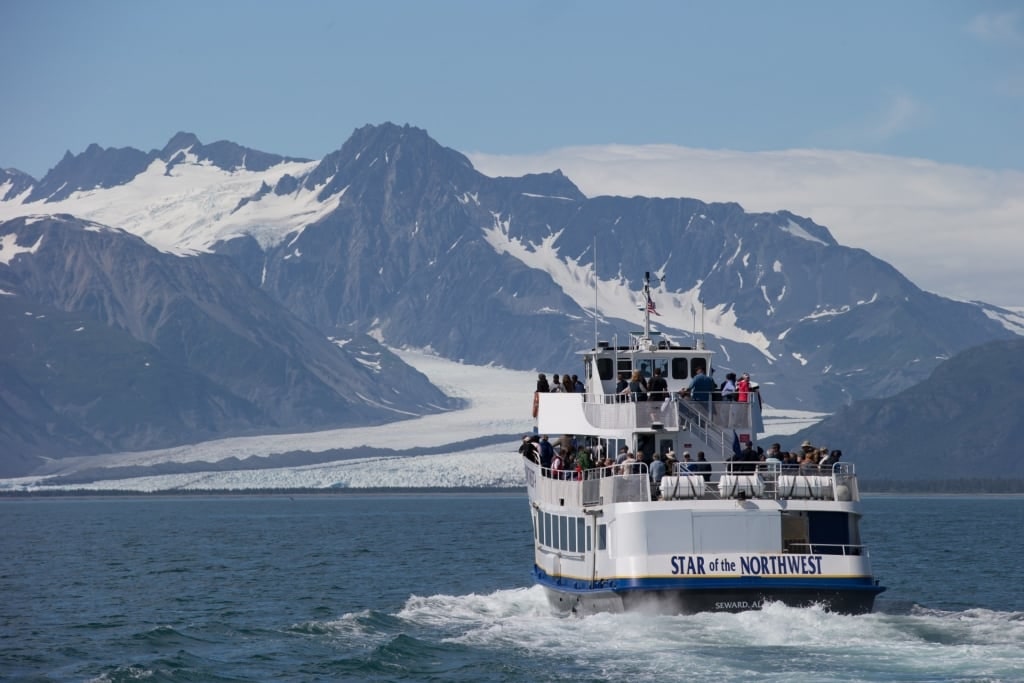
Kenai Fjords National Park
Travelers of ages and physical fitness levels can experience Alaska’s glaciers up close. Arguably some of the most visually spectacular glaciers are tidewater glaciers. These are accessible on guided day trips with boat operators.
Some tours offer travelers the option to venture even closer to a tidewater glacier on a sea kayak or raft. However, anyone worried that they might not be up to the task of kayaking in icy waters can still get a terrific view from a sightseeing boat.
What’s the easiest glacier to get to in Alaska?
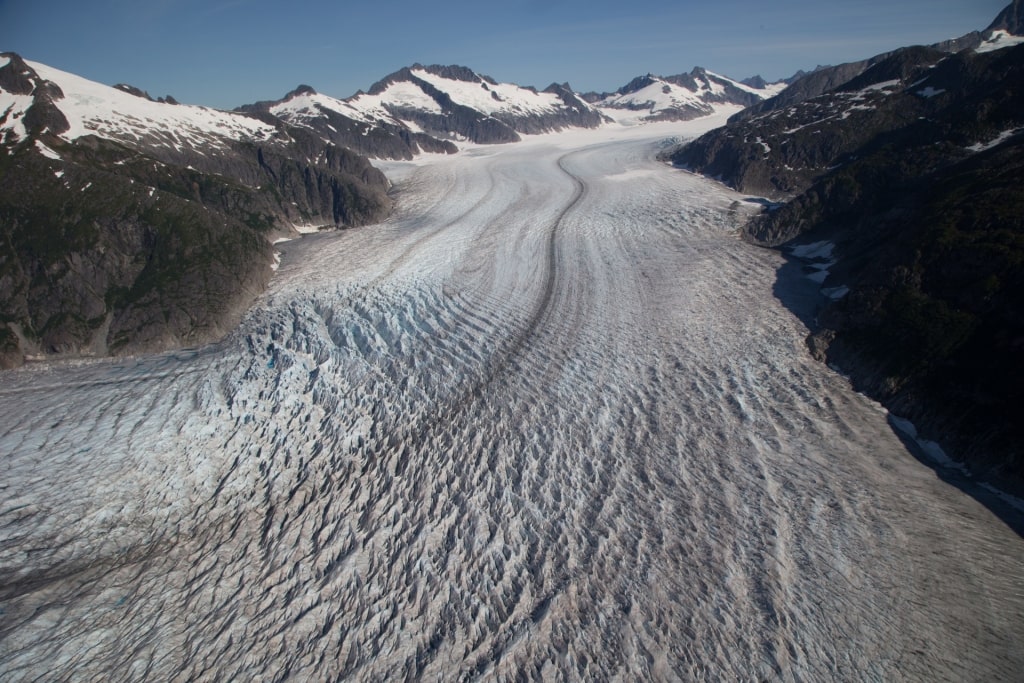
Mendenhall Glacier
A few glaciers in Alaska are reachable by car or bus, making them perfect for a day trip. Mendenhall Glacier, located only 13 miles from Juneau, is especially easy for a quick stop. Byron Glacier, meanwhile, is a manageable 50-mile drive from Anchorage. Exit Glacier is a relatively short drive from Seward.
How cold is it on a glacier in Alaska?
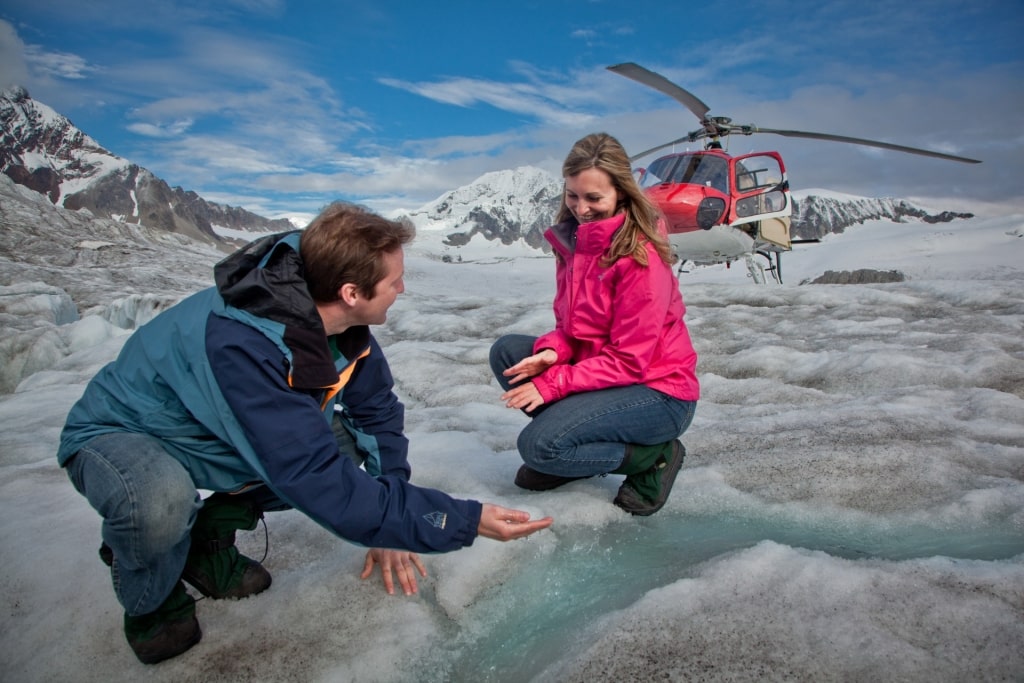
Glacier in Alaska
Even in summer, it will be colder near a glacier. In the southern part of Alaska in June, temperatures hover around 50°F to 60°F (10°C to 15°C). Pack extra layers to throw on as you approach an ice field, then peel them off after you leave.
You can visit the best glaciers in Alaska on our premium cruises and cruisetours. Admire these stunning natural wonders from the comfort of a private veranda and embark on shore excursions to see them up close.
Book your Alaska cruise on our website or call one of our vacation specialists at 1-800-852-8086.
